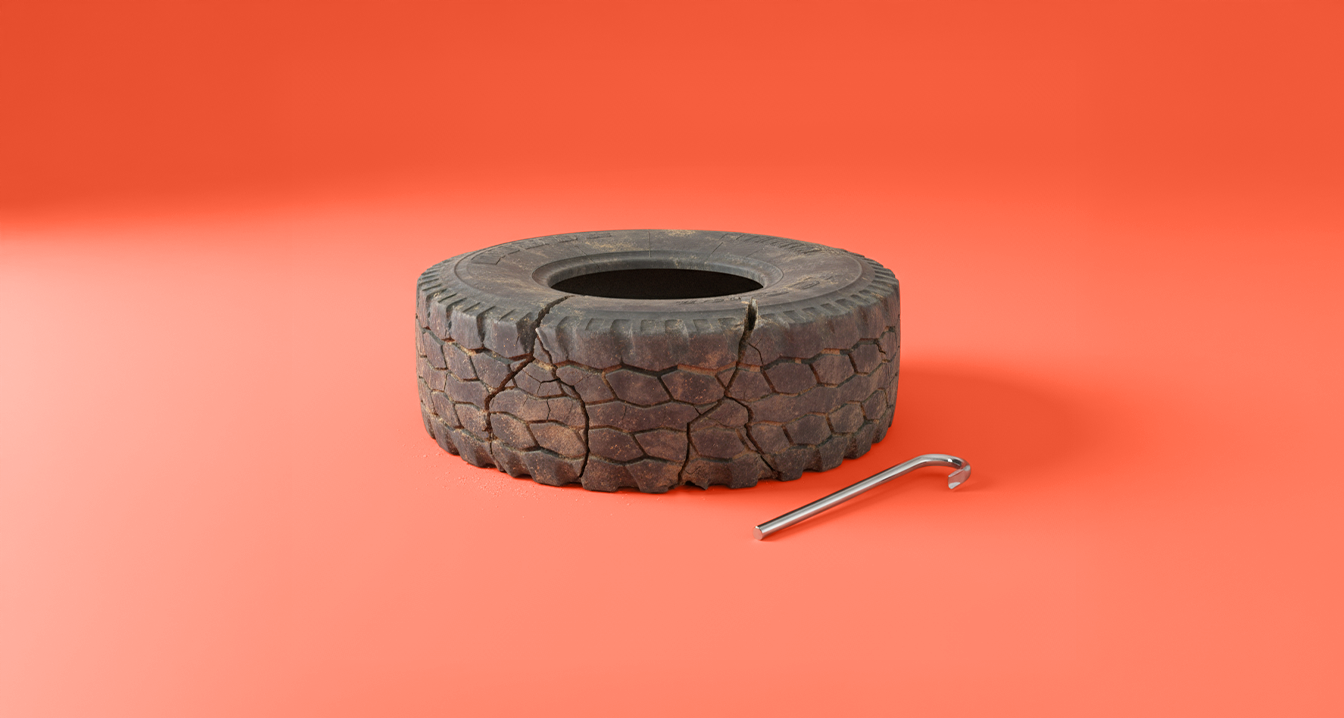Driving downhill is a real challenge for professional truck drivers. These extreme conditions put extraordinary pressure on all vehicle components, especially tires, which are the first line of defense between the truck and the road.
It is certain that slopes directly affect the efficiency and life of truck tires, as they are subject to severe friction resulting from prolonged braking, and hence increased temperatures, as well as huge mechanical stresses caused by the weight of the cargo and the vehicle.
In this comprehensive guide, we will review the best strategies for maintaining truck tires while driving on slopes. We will cover all technical and practical aspects including: choosing the right tires for slopes, smart braking techniques, optimal speed management to maintain tire balance, and even conducting regular checks before, during and after crossing dangerous slopes.
We also discuss the most common mistakes that lead to tire damage, and the experiences of professional drivers who spend long hours crossing mountains and rough areas.
This information and others will help you extend the life of your truck tires and enhance your safety on the road by turning downhill driving challenges into an opportunity to show your professional skills in truck management and maintenance!
There are differences you should be aware of between car and truck tires
Car tires differ from truck tires in many aspects, including design, structure, materials used and durability. These differences result from the nature of use and the different pressures that each category of vehicle is exposed to. Here is a simple overview that shows these differences:
- styling
You notice that car tires are smaller and softer, designed for speed and comfort with a balanced pattern for grip and noise reduction.
Truck tires are larger and thicker, with a deeper pattern to withstand heavy weights and rough roads, and have additional steel layers to enhance durability and endurance under high pressures.
- substances
Car tires are made from a combination of natural and synthetic rubber for speed and comfort, while truck tires rely on reinforced rubber and additional layers to withstand heavy weights, with a much higher load index to withstand several tons.
- Performance and usage
Car tires are designed to be ideal for daily use on paved roads, with a focus on comfort and fuel efficiency, while truck tires are designed for heavy loads and rough roads, as they have a high carrying capacity and a strong grip on different surfaces such as rocks and dust.
- Shelf life and maintenance
Car tires usually live between 40-60 thousand km, while truck tires last up to 100 thousand km or more due to their durability, but they need frequent pressure checks due to their constant heavy load.
Essential procedures that are essential before driving downhill
Before you turn the key to your truck and face the challenges of rough mountain roads and slopes, remember that safety does not depend only on driving skills, but requires smart preparations that may be the difference between a safe journey and a disaster.
Here are the most vital procedures that cannot be ignored, recommended by experts to protect you and your truck in these harsh conditions:
- Don't go off without this equipment
It helps you keep you safe while driving downhill, including:
- Off-road spare tires
- Air pressure monitors
- Emergency equipment, including: powerful reflective warning triangles, portable generators, and quick tire repair kits.
- specialized fire extinguishers.
- extended first aid kits.
- Check oils and cooling fluids
Engine faults are one of the most annoying situations for you, especially when they occur on slopes where it is difficult to get help, so avoid such situations by carefully checking the engine oil level before starting, and ensuring the adequacy of the coolant.
However, if you notice an abnormal rise in engine temperature during the journey, you should try to park the truck in a safe place away from the road edge, turn off the engine and let it cool down for 15-20 minutes, while avoiding opening the radiator cover while it is hot to prevent burns.
- Make sure the headlights are efficient
Proper lighting in trucks is a crucial factor for safety, because road conditions change between heavy fog, heavy rain, lack of artificial lighting on most mountain roads, or sudden slopes.
Therefore, it is necessary to perform a comprehensive inspection before starting, make sure that all lamps work efficiently, clean the lenses from dust and mud, and adjust the lighting angles to ensure the best range of vision.
Also check the rear lights, brakes, warning lights, and registration plate lights, and don't forget to carry an extra set of lights with you.
- Your safety starts with checking your truck tires
Truck tires are exposed to wear factors with continued use, which requires regular monitoring.
Did you know, for example, that tire treads reaching the legal limit of wear threaten your safety, especially in difficult road conditions. However, you can follow a set of steps to avoid exposure to risks before it is too late.
Also, don't forget the tire pressure, which gradually decreases over time. It is obvious that maintaining ideal pressure is not just a routine procedure. It is the basis for your safe control of the truck, especially on mountain roads, slopes, or during long trips.
Maintaining optimal pressure protects tires from uneven wear, prolongs their life and saves you from replacing them early. Therefore, make sure to check the pressure regularly and check it before every long journey or when driving downhill.
Technical reports indicate that worn tires lose more than 50% of their grip on mountain roads and wet slopes.
Driving tires in slopes.. Is your choice right for safe and enjoyable trips?
Sloped roads require Installing special frames High-performance tires keep your truck stable and ensure your safety. Are your current tires equipped to meet these challenges?
Rugged mountain areas or slopes need tires with strong sides and a high grip “Traction Tires” that ensure stability, control, and durability.
These tires are designed with deep blades to absorb water and prevent slipping on wet roads. They also contain metal spikes or sticky materials in very cold or icy areas. They are made of reinforced rubber to withstand the truck's weight and overload. They withstand high weights without losing performance on slopes, and provide better stability when braking on steep roads.
Safe downhill driving strategies

You may make a serious mistake while driving your truck on slopes as it relies entirely on traditional brakes. This leads to serious risks, the most important of which are: high brake temperature, loss of efficiency, rapid wear of brake pads, and then exposure to the risk of slipping and loss of control.
The best solution in this case is to use engine brakes intelligently. The action of these brakes depends on the engine's own resistance to slow down the truck by switching to a lower transmission speed, using a low-speed control system, distributing braking effort between the engine and the brakes, preventing overheating of braking systems and improving truck control, especially with heavy loads, and then Saving fuel consumption up to 15%.
Experts advise you to control the speed and maintain a constant speed that does not exceed 30-40 km/h, while pressing the brakes intermittently rather than continuously, provided that you hold the steering wheel with both hands and maintain a double safety distance, and of course avoid overtaking completely while descending.
It's important to avoid sudden gear changes and pay attention to engine temperature warnings. Mastering this technology and using all your truck's resources intelligently transforms downhill driving from a serious challenge to a safe and smooth experience.
How does overloading affect tire wear on slopes?
Overloading is one of the most important factors that accelerate the wear of truck tires, especially when driving on slopes and mountain roads. Additional pressure on tires with increased gravitational forces and friction may lead to risks of high rubber temperature, and may lead to tire explosion and loss of control of the truck.
On the other hand, overloading often leads to truck imbalance, causing pressure to be concentrated on specific tires rather than distributing it evenly, thus causing rapid wear in specific parts of the tire and reducing its life span. This effect increases in slopes due to lateral thrust and then tire rupture or slip.
Studies show that exceeding the maximum load limit increases the likelihood of tire explosion by more than 60% on rough and steep roads.
Dealing with high tire temperatures during long descents
Sensors may alert you to high tire temperatures, or smell burnt rubber. In this case, it is recommended to stop in safety zones and let the tires cool down.
Avoid pouring water on hot tires suddenly, because rapid cooling causes the rubber to crack. Instead, wait a few minutes before resuming your journey, or use a tire cooling system if your truck is a modern type equipped with this system, and replace the tire if it shows cracks or bulges before continuing the journey.
How to avoid a disaster? Causes of truck tires exploding in ramps
One of the most serious situations you may face as a truck driver while going downhill is tire explosion, which is often the result of a set of mistakes you may make, the most important of which are:
- Continuous pressure on the brake pedal causes the tire temperature to rise.
- Ignore the air pressure check before the trip, which causes an increase in the contact surface with the road in the event of low pressure, or the concentration of pressure on specific points in the event of excessive pressure.
- Exceeding the maximum load limit, which leads to increased pressure on the sides of tires, higher internal temperature and structural stress.
- Neglecting regular maintenance of tires and ignoring warning signs, including: cracks on the sides, irregular wear of the patterns, bulges or bubbles in the sidewall.
- Driving downhill too fast causes more friction with the road and loss of control when the tire bursts.
- Not installing tires suitable for slopes, or not designed for heavy loads and not suitable for mountain roads.
- Ignore cooling periods during long trips, as continuing to go down long distances without rest leads to the accumulation of heat in the tire tissues and poor rubber resistance.
Dear truck driver, downhill driving is not just a challenge of abilities as it is a real test of your wisdom as a professional driver in terms of choosing the right type of tires, maintaining the right pressure level and the way you handle the brakes.
This is taking good and regular care of tires and is an ethical and professional duty towards yourself and others on the road.
The principles of preventive driving suggest that driver awareness and regular maintenance follow-up are the first line of defense in difficult driving conditions.
During the previous lines, after learning about the secrets of keeping your truck tires on ramps, you have the knowledge to convert dangerous roads into safe tracks.
The skill here is to apply these tips regularly, not just when you face problems.







